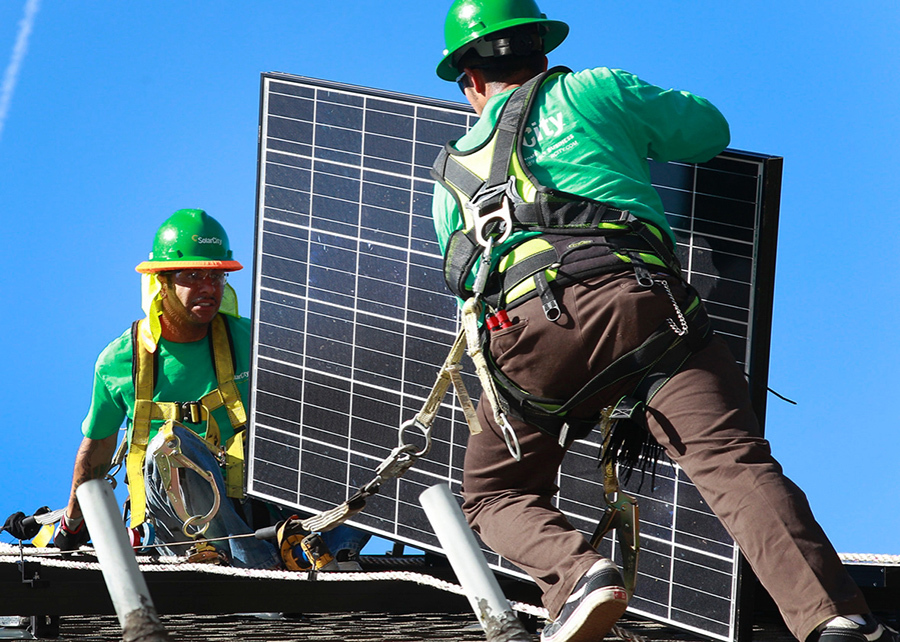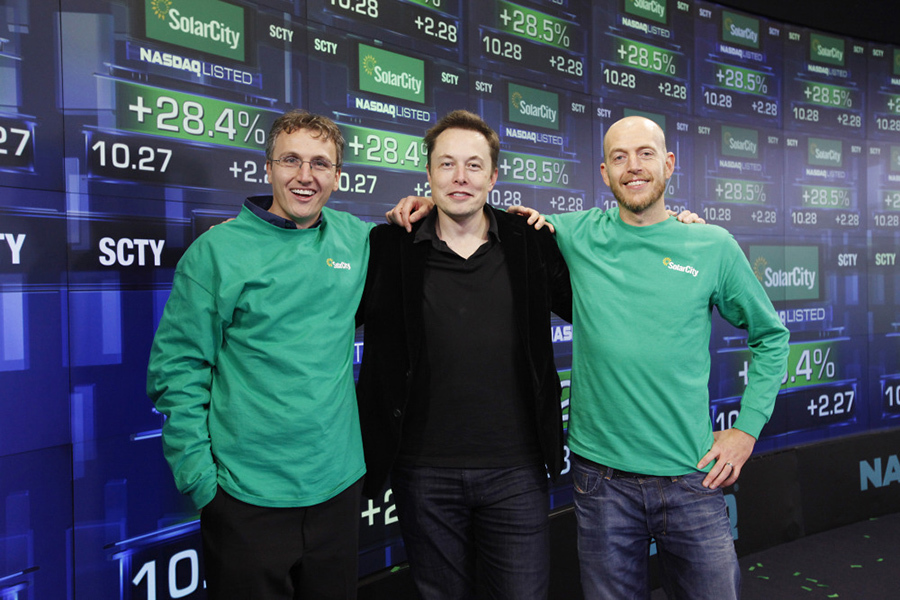Modern miracle of SolarCity, or Solar panels as an object of leasing

Tesla and SpaceX Ilona Mask (Elon Musk) are impressive. But SolarCity, which he founded with his brothers, can turn the world around.
One cannot but agree that the persona Ilona Mask, as well as his bold projects, cause genuine universal interest: what only are the company for the production of electric cars Tesla Motors and the private business SpaceX to create space rockets. And it is not surprising that the biography of Mr. Mask became the bestseller of this year. But for me the most important and interesting venture of an immigrant from South Africa was the one that attracted much less press attention. This is SolarCity - a company whose goal is to cover the roofs of American citizens with solar panels.
Mask's work on Tesla may evoke some associations with the writings of Henry Ford. However, SolarCity makes the parallel between these two successful businessmen much more obvious. Musk himself is the manager of the company, the concept of which he proposed to his two cousins: Lyndon Rive, who currently holds the post of chief executive officer, and Peter Rive, Lyndon's brother, who is currently the main technical partner. director of the company.
')
When it comes to creating new industries, developing a new technology is just the beginning. As noted earlier, innovation in business models and processes can be just as important as the moment of insight itself. Henry Ford did not invent the internal combustion engine. But he put together and perfected a combination of processes, methods and tools. A super efficient assembly line, a full production cycle, a huge scale, a bold personnel policy, a salary for workers $ 5 a day and advanced financing techniques made a revolution in the automotive industry, turning the car from an expensive toy for the rich into the usual element of life for middle class citizens.
Now Tesla has opened a new milestone in the sale of cars - cars are delivered directly to customers without the participation of dealers. And the company is working to ensure the full production cycle, engaged in the construction of its own factory for the production of batteries. But, in fact, the company sells a small amount of incredibly expensive sports cars to very rich people. Tesla Motors is currently at the same stage of development as Ford Motor Co. in 1903 before the appearance of Model T.
The company SolarCity, which I first wrote about six years ago, when it had only a few hundred employees, has a lower total market value than Tesla ($ 5.7 billion against almost $ 34 billion). However, there are arguments in favor of SolarCity, which has all the prerequisites for developing into a more economically powerful company. The company employs about 12 thousand people and the company offers 500 new vacancies every month, as Lyndon Reeve recently told me. During this year, every month, 12,000 people were added to the army of customers of SolarCity in the United States. Already at the end of July of this year, it was reported that the number of customers of the company amounted to 262,495 people as of June 30. (Both companies usually give information about losses, rather than profits.)
SolarCity, which set a course to equip roofs of houses and buildings with solar panels, did not invent solar modules themselves. But, like Ford Motor Co., the company tied together and perfected a combination of functions and disciplines: efficient assembly, savings due to increased production, vertical integration and innovative financing techniques — all this can make mass implementation a reality. And SolarCity is constantly looking for and finding ways to expand its market.
Let's consider. A few years ago, the high cost of solar panels was prohibitive for their massive implementation; homeowners would have to immediately lay out from 30 thousand to 50 thousand dollars in exchange for the fact that over the next decades this decision will bring them savings. So SolarCity has developed a strategy based on the idea of renting, which allows people to install batteries on the roofs of their houses at no cost on their part and immediately benefit from it in the form of money saved. According to GTM Research, 72% of the total installed solar panels were rented. SolarCity accounted for 34% of this number, which makes the company the undisputed market leader today.
The ability to save on electricity without the need to initially invest is an attractive proposition. But the creation of such systems is very capital-intensive. A company such as SolarCity faces the same problem as regular customers - the need for huge investments, despite the fact that revenues (in the form of tax deductions, leasing profits or payments for electricity) will not appear in the coming weeks or even years. This is an unprofitable position - at least in the first years (the net loss of SolarCity in 2014 was $ 375 million). To continue growth, the company has developed another new set of financing techniques. It makes deals with large Wall Street firms such as Goldman Sachs to finance the construction of thousands of systems, and combines leasing offers into special packages that can be purchased by private investors.
Installing solar panels on the roofs of houses is a business in which it is difficult to reduce costs by increasing production. The fact is that so far there is no mass demand for this proposal: 30 panels on the roof are here, 25 are there ... But SolarCity found a way that turned this retail business into something resembling a wholesale business. The company entered into a series of deals with the Department of Defense, hoisting solar panels onto the roofs of military personnel: 6,500 homes in Hawaii and 6,000 more in San Diego. In California, which is the largest market for SolarCity, the company has built a network of 40 warehouses serving as distribution points for individual projects. In an attempt to organize the entire production cycle, the enterprise Ilona Mask acquired a solar panel manufacturer, Silevo, last year. Now SolarCity is building a huge plant in Buffalo, New York, which will supply low-cost panels for further installation.
Now the company operates on a grand scale, uses the experience and the latest financing techniques in order to break into a new market: small business. For huge companies with good income and a lot of buildings with giant roofs (for example, Wallmart or Ikea), installing solar panels is an obvious solution in cases where the offer is tempting. Solar panel installation companies want to work with such customers, because installing an array of 5,000 panels is far more economically beneficial than building 100 arrays of 50 panels each. This left aside owners of small businesses that can offer roofs of a much smaller area, and their income is much less. “Usually, solar panel installers are not interested in a commercial system of less than 500 kilowatts,” Lyndon Reeve told me during an interview at the end of July.

A week ago, SolarCity announced that it would offer leasing to small businesses. The conditions are similar to those that the firm offers to homeowners: at the very beginning, no capital investment is required, the customer immediately starts saving from 5 to 25 percent on electricity, and also receives a guarantee that the tariffs will not rise during the 20-year lease term. The minimum size of systems can be equal to 30 kilowatts (100-125 panels). “We built the infrastructure in order to independently install the panels,” Reeve told me. By installing panels on thousands of roofs, SolarCity has developed processes for quickly installing batteries on roofs at low fixed costs. In addition, SolarCity combines financial innovation — leasing in the solar power industry — with another. For example, in California, enterprises may participate in separate energy programs, according to which the owner of the property can receive financial resources in order to make some improvements, and then gradually pay a special tax - something like a property tax.
Instead of conquering its place in the sun in existing markets, as Tesla is trying to do, SolarCity turns to innovation to create entirely new markets, as Ford did. Of course, between SolarCity 2015 and Ford Motor Co. Sample 1915 there are a number of important differences. Sales Model T basically did not depend on government subsidies. SolarCity, like other solar cell installation companies, has benefited enormously from a federal tax credit to finance long-term investments in solar energy (this program will end in 2016). Henry Ford quickly made a huge fortune even though he had invested in production capacity and hired thousands of employees. Does SolarCity have any profit? More likely no than yes. At least as of the moment. The company reported that in the second quarter, revenues increased by 67 percent compared with last year, while current losses amounted to $ 132 million. However, the great advantage of the company is that it develops during the period when there is money to finance the construction of solar array arrays. At the end of last month, the company announced that it plans to raise another $ 124 million through leasing payments from its customers.
Source: https://habr.com/ru/post/293408/
All Articles